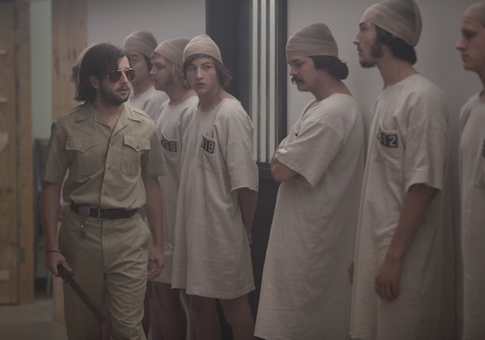As the old saying goes, power corrupts. But absolute power corrupts absolutely, forcing you to make your peers do jumping jacks and pushups when you partake in a study simulating the effects of prison life on college students.
The Stanford Prison Experiment is a dramatic recreation of Philip Zimbardo’s famous 1971 experiment of the same name. Anyone who has taken Psych 101 will likely be familiar with it: Zimbardo took college students, separated them into guards and prisoners, and put them in a "prison" located in one of Stanford University’s buildings. Things quickly spiraled out of control, with guards treating prisoners sadistically. This led Zimbardo to suggest the simulation lent credence to the idea that people will participate in wicked acts even if they do not consider themselves to be wicked because the structure they find themselves in demands wickedness. The banality of evil, and so forth.
Billy Crudup, who wears a Mephistophelean goatee and longish, wavy hair that seem weirdly appropriate for the role, plays Zimbardo. The film does a good job of setting the scene for those who are unfamiliar with the experiment: We meet a group of college kids whose fate in the eponymous experiment is determined by a coin flip. Half become prisoners, half guards. The guards are given instructions on how to treat the prisoners and allowed some wiggle room to improvise. The prisoners, meanwhile, are given no instructions except for those given to them by the guards.
The most sadistic of the guards is Christopher Archer (Michael Angarano), who adopts a southern accent modeled on the evil warden from Cool Hand Luke. He plays the role he’s been given with relish, smacking the bars of the prisoners’ "cells" and forcing them to recite the number they’ve been assigned repeatedly, endlessly, until they’ve accepted it as their own name. His sadism gets results: By the time the prisoners are asked to write letters to loved ones asking them to visit, one of them signs his number instead of his name.
The prisoners are by turns docile and agitated, with 8612 (Ezra Miller) leading the pushback. Once he realizes that the guards aren’t going to let him do what he wants—and after one of them pops him in the mouth for attacking a guard—he cracks under the strain.
The structures created by Zimbardo affect more than just the purported subjects. A former prisoner asked to observe the experiment assumes the role of a cruel parole board member. A priest who comes by to counsel the jittery prisoners accepts the role he’s given with gusto. And Zimbardo himself dives into the role as overseer, carrying around the coin that determined the fate of the kids as a sort of totem while he watches their depravity.
The experiment itself is of questionable scientific value, as one of Zimbardo’s fellow professors notes when he asks some relatively innocuous questions about variables and such. Others, including participants of the experiment, have also questioned Zimbardo’s conclusions. "My days as a guard were pretty boring. I just sat around," John Mark, one of the guards, told Jon Ronson in his book So You’ve Been Publicly Shamed. "If Zimbardo’s conclusion was the true conclusion, wouldn’t it have applied to all the guards?"
Experiment or simulation, scientific or no, it was still a rather interesting event, one that is rather perfectly designed to give actors room to work. Crudup excels as Zimbardo, casually sliding into the role of evil prison boss so subtly that we almost don’t realize what’s happening. Angarano aside, the younger actors who play the subjects are hit and miss, but on the whole their inexperience feels oddly helpful. They seem a bit lost and out of place, and that disorientation helps drive home the weirdness of the situation they found themselves in.
